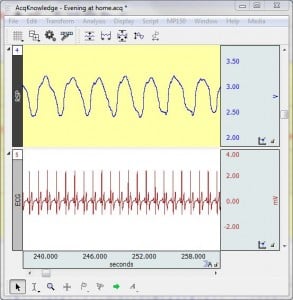New Citations | Psychophysiology, Chewing Study, Pulse Wave Velocity

Recent studies in Psychophysiology, EMG, ECG and PPG measurement utilizing BIOPAC software and hardware:
Fight or Flight (Reflex Response Time)
“Fight or flight” is a physiological response that occurs due to a perceived threat to survival. It can physiologically be observed through an increase in heart rate, respiratory rate, blood pressure, oxygen availability, and other mechanisms. In this experiment, researchers at the University of Wisconsin-Madison investigate if the fight or flight response induced by an auditory stimuli will quicken reaction time. Respiration data for this study was collected using a BIOPAC SS5LB Respiration Transducer and the Biopac Student Lab System (BSL4 Software and MP36 Data Acquisition Unit). Read the full study: The Effect of Sympathetic Nervous System Stimulation on Skeletal Muscle Reflex Response Time (Anna Batley, Rebeca Certa, William Dyke, Celena Ho, Abigail Moeller).
Chewing the Fat
The objective of this Pharma Journal study was to examine the reproducibility of twelve mastication variables for entire duration of chewing, variables per chew and at three different stages (early, middle and late). Electromyography (EMG) of eight human subjects was conducted for two different recordings in a session. The variables were recorded as the bioelectrical activity of masseter muscles observed during chewing of five different textured foods. It was concluded from this study that chewing behavior is highly reproducible within a session for human subjects. The EMG data was collected using BIOPAC EL500 Electrodes, and a BIOPAC MP150 System with AcqKnowledge software and EMG100C Amplifier. Read the full study: A study to investigate reproducibility of chewing behaviour of human subjects within session recordings for different textured Indian foods using electromyography (Sarvesh Rustagi, Navdeep Singh Sodhi and Bhavnita Dhillon).
Easier Alternative
Arterial stiffness is a reliable prognostic parameter for cardiovascular diseases. The effect of change in arterial stiffness can be measured by the change of the pulse wave velocity (PWV). This study by the Journal of Clinical Monitoring and Computing compares the BIOPAC System to the widely-used Complior System for measuring PWV. The Complior system is used to measure PWV between the carotid and radial arteries by means of piezoelectric clips placed around the neck and the wrist. The BIOPAC system is an easier to use alternative that uses ECG and simple optical sensors to measure the PWV between the heart and the fingertips, and thus extends a bit more to the peripheral vasculature compared to the Complior system. The BIOPAC components used for this study are the TSD200 Photoplethysmogram (PPG) Transducer, PPG100C Amplifier, and AcqKnowledge software. Read the full study: Comparison between pulse wave velocities measured using Complior and measured using BIOPAC (Marit H.N. van Velzen, Arjo J. Loeve, Sjoherd P. Niehof, Egbert G. Mik).
Stay Connected